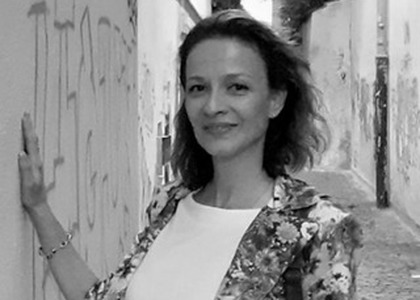> [Archived] Interviews

Interview with director Andreea Tănăsescu
A performance that has its roots in the love story between princess Maria Cantacuzino and composer George Enescu will take place on Friday, March 10th, 2023, for the first timeon the stage of the National Opera in Bucharest. Director Andreea Tănăsescu, the one who is also responsible for the concept of this event, talked us through The Diary of a Romance.
The Diary of a Romance is the title that will be displayedon Friday, for the first time, at the Opera in Bucharest. It is a contemporary dance-theatre performance that has your name on it. What inspired you to create such a performance?
The diary of Maria Cantacuzino-Enescu, that I came upon in 2012. It seemed to me that I had uncovered an extraordinary world, an old Romanian one, things that I didn't know and things that I felt needed to be out there in the world. I wrote a theatre text, which got published at the Musical Editing Press in 2018, and I kept waiting for a chance to make it happen on stage. The text has its roots in real events that took place around the life of the great personalities George Enescu, Maria Cantacuzino and professor Nae Ionescu, but from a romantic view. That is, the text aimed to actually radiograph the souls of these great personalities, without claiming to make them come alive on stage as they truly were. Art is a subjective act, after all. Before anything else, we aim to produce a work of art, through music, dance and multimedia.
As a director, choreographer, but also text author, what were the challenges that you faced during the making and staging the performance?
It was a very long journey, starting with the proposal and until its realization, but I received an exceptional environment put at my disposal by the Bucharest National Opera, through the director of the Bucharest National Opera, Mr. Daniel Jinga, and, thus, a new artistic program managed to come alive. It is dedicated to Romanian artists and Romanian initiatives, but also to the new ways of staging performances. This program is called Coup de théâtre at the opera and it is coordinated, as I was saying, by Mr. Daniel Jinga. Through this program, technically, this performance came to be.
It was a challenge because there are also independent artists within this project, together with hired artists of the National Opera, a small association - an association that I've been running, A&A Asociated Artist - together with the Bucharest National Opera. Thus, there is an independent scenographer, Cristina Barbu, a media artist - Vali Chincișan, Daniela Fries - costume creator... all these people are independent artists, together with the actors from the National Theatre:Irina Movilă, Gavriil Pătru, Armand Calotă and other independent actors, such as Marina Fluierașu, who plays the role of young Maruca. This was a challenge, to have the same role for two actors, who were of different ages and looked different.
We did not have as our purpose to bring them on stage as they truly were. It is a convention, but we only wanted to radiograph the souls of these astonishing personalities.
Let us talk about the musical side of things, which also encompasses works by George Enescu. How has the selection been made?
I listened to many works by our great composer and I had to find an interesting link to the dramaturgy of the play. I used works from the composer's youth, but also from his mature period, together with lesser-known worksfrom that era, in order to bring on stage the perfume of those times.
The selection was made by myself, although I also received great help from composer Cătălin Crețu, who managed to bring to the table an interesting view, but also some of his small works, insertions that I have also added to the sound of this performance.
The purpose was to use as many creations by George Enescu as possible, but not complete ones. They are musical fragments which attach themselves to the dramatic structure of the play.
Translated by Adelina-Maria Mănăilescu,
University of Bucharest, Faculty of Foreign Languages and Literatures, MTTLC, year I
Corrected by Silvia Petrescu














